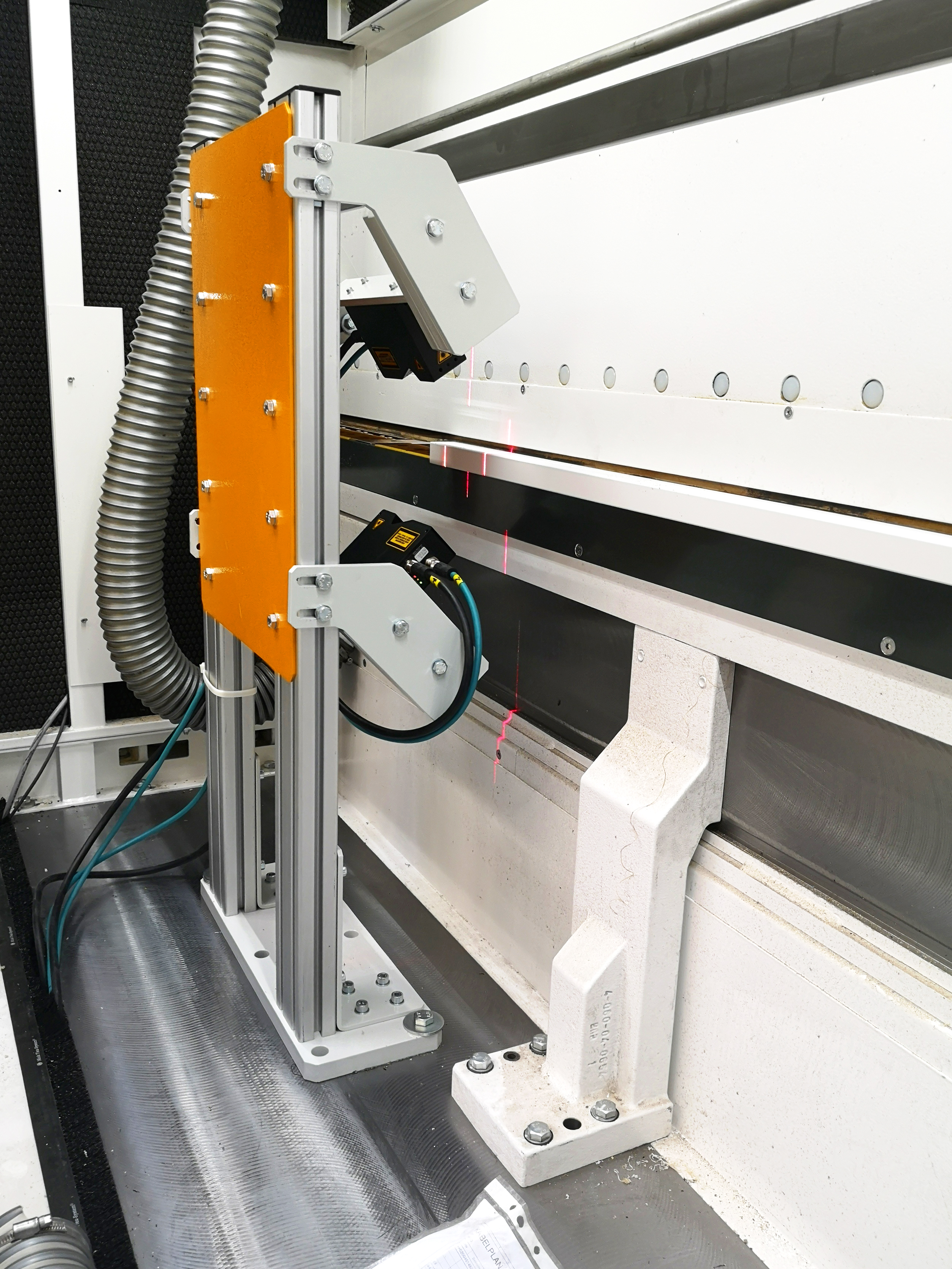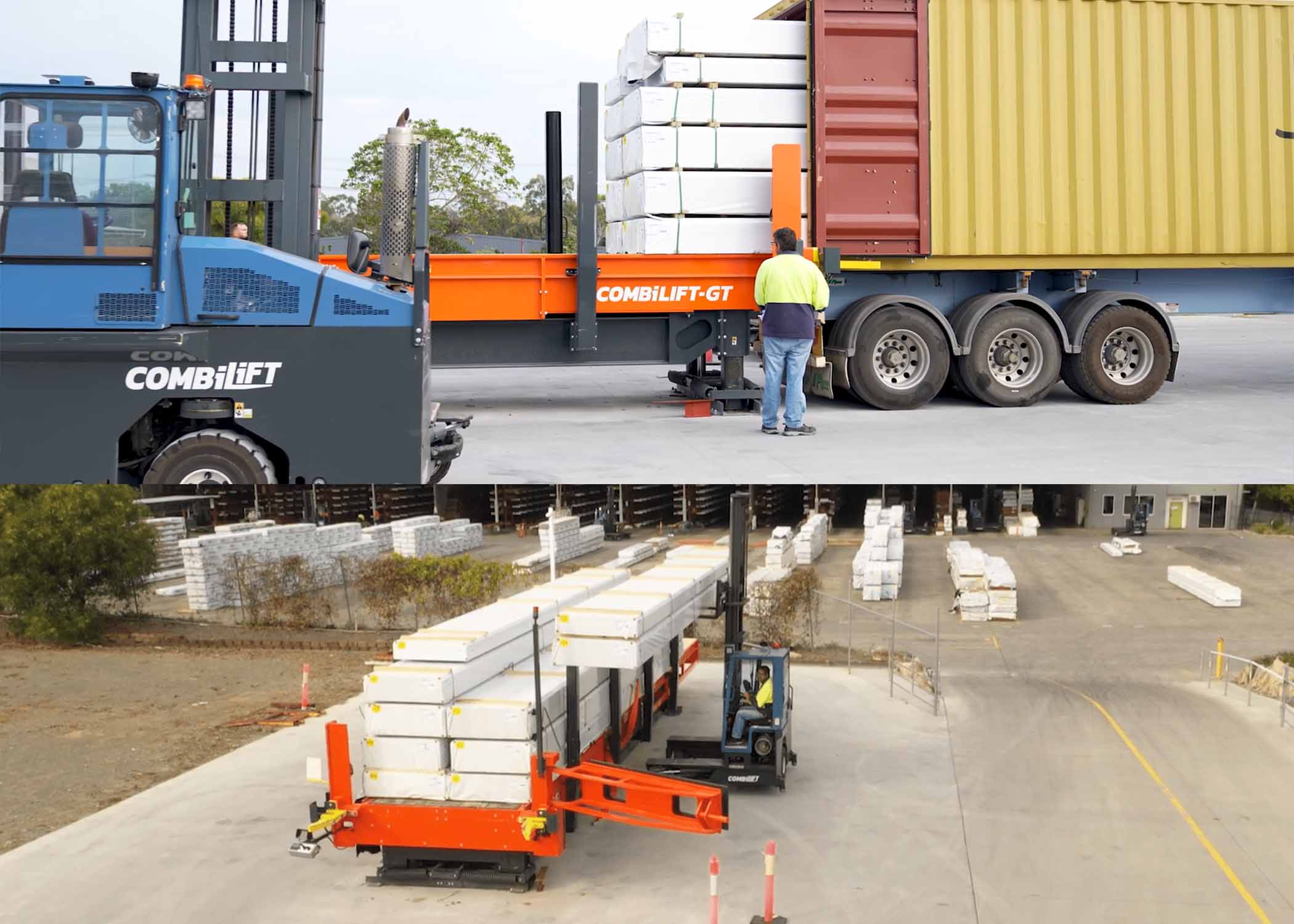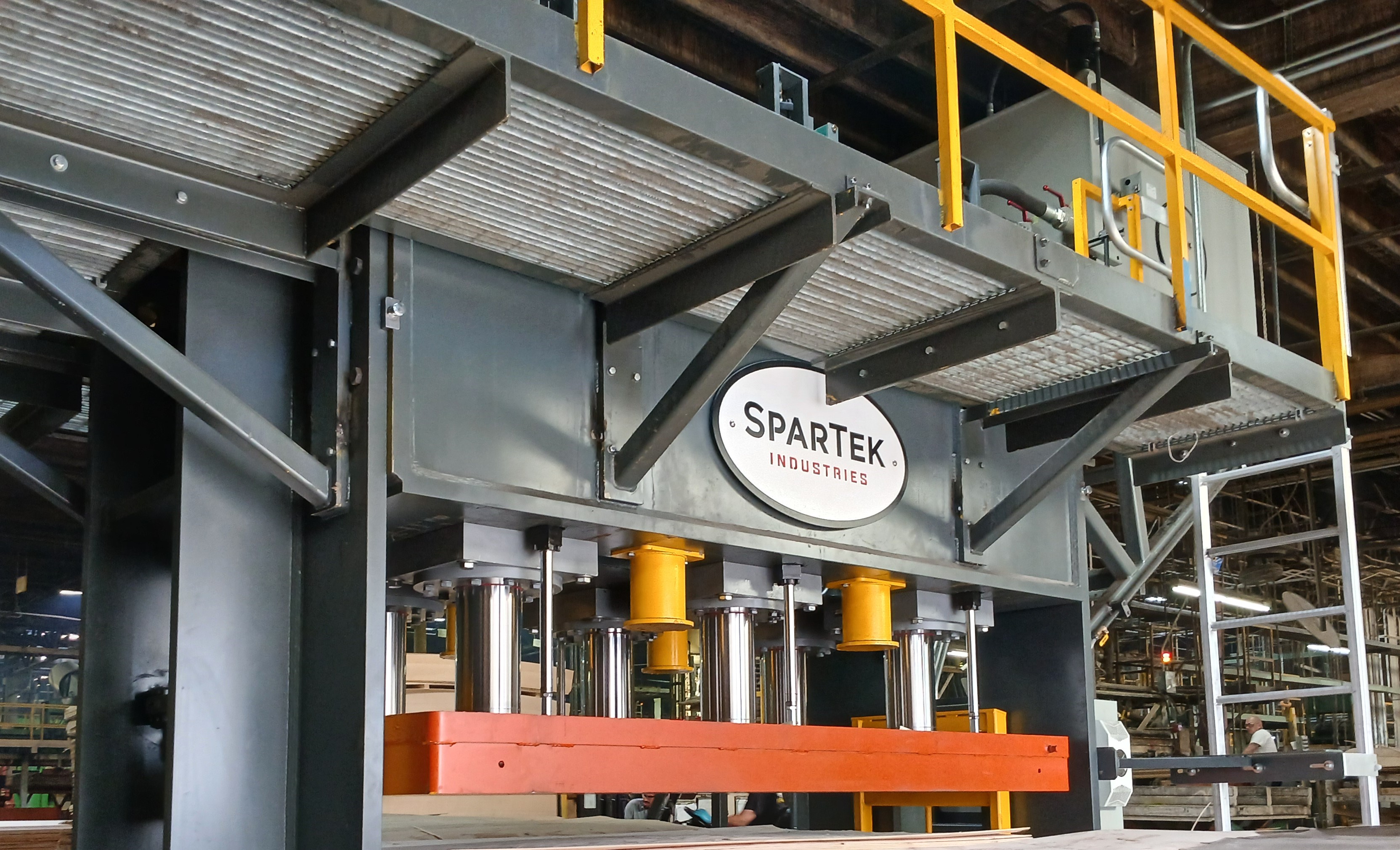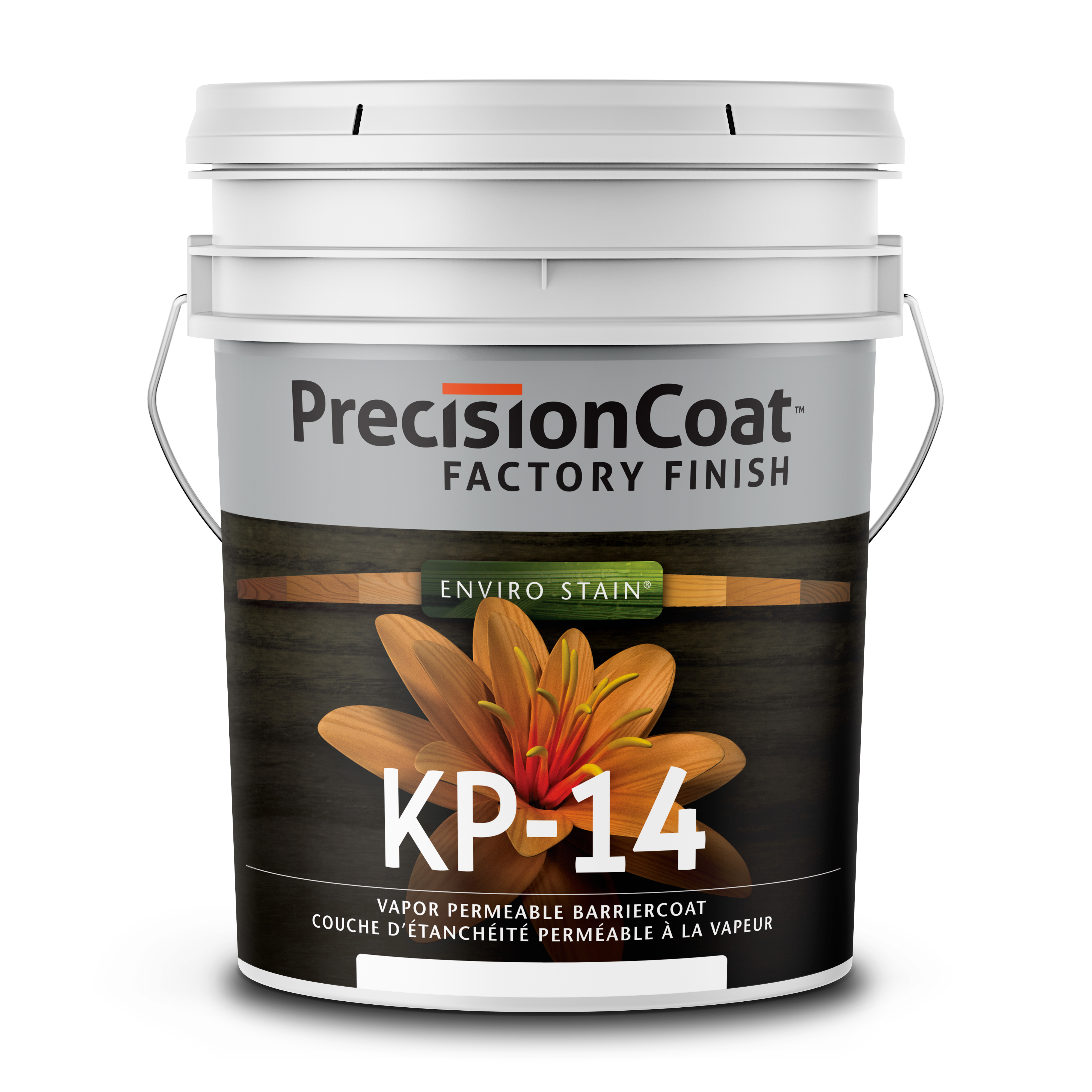The Timber Products patching line is a single level machine that processes 8,9 and 10 ft veneers. Timber Products needed to continue using the boat/football traditional patch. For this we added glue and tape to ensure the patch doesn't fall out. For this line, the butterfly patch is often used, as it's the most efficient and does not require the use of glue and tape.
Raute’s Veneer Patching Line R7 can deliver the quality and production boost that mills need to succeed. At the same time, it reduces their dependence on labor and improves veneer grading with state of the art camera systems, making sure every patch counts!
The patching technology includes at least one patching level with one or two patching heads, depending on the veneer sizes. The patching heads are permanently installed in fixed positions on the patching frame whereas the veneers are moved and positioned under the heads.
A line may comprise 1- 4 patching levels and a by-pass conveyor which gives an additional grading feature with uniform patching rules from the line camera recipe. With the latest intelligent camera technology the patching decisions and grading rules can easily be controlled in accordance with the most common grading standards. And you never over patch, nor under patch!
Innovation of the Year Entry E
EDGEINSPECT
Entered By: Fagus GreCon Inc.
Description: Early, Reliable 3D Fault Detection. The quality of panels, doors, and furniture elements depend on the condition of their edges. Unlike traditional optical measurement methods that rely on 2D images, EDGEINSPECT captures the three-dimensional structure of the edges. EDGEINSPECT uses lasers, creating a three-dimensional image of the edge. Structures and deviations are reliably recognized and are unaffected by color or surface structure variations and differences. 
Date of First Use: Late summer/Fall 2024
Benefit 1: Leads to fewer rejects, saves valuable production time and avoids expensive complaints. The defect size detection of 0.5 mm² in the surface and 0.2 mm in the depth allows precise and fast identification of defects such as open glue joints, broken corners or protruding decorative strips.
Benefit 2: Helps avoid serial errors and detects even the smallest defects, regardless of colour, grain or material thickness.
Measurable Results: Installed and being used at cabinet and furniture makers like Nobilia.
Additional details:
Forget the uncertainties of camera-based systems! Conventional technologies quickly reach their limits, especially with coloured or textured surfaces, as they often have difficulty distinguishing between design features and real defects - and require constant readjustment by employees.
GreCon EDGEINSPECT goes one step further: our compact laser sensors measure the 3D geometry of your components with millimetre precision - regardless of colour or structure. Instead of interpreting images, the system analyses precise heights, depths and widths and delivers reliable results directly in the production process.
Benefits at a glance:
- Precise geometry measurement: No image interpretation, but direct analysis of 3D parameters.
- No manual teach-in process: Saves time and reduces the effort involved in production changeovers.
- Independent of decor and environment: Works reliably no matter how coloured or textured the material is.
- Clear defect differentiation: Recognises real break-outs and avoids pseudo defects thanks to precise geometry data.
- User-friendly: Easy to integrate and use - for greater efficiency and quality assurance.
Thanks to its detailed geometry detection and intelligent exposure control, EDGEINSPECT detects even the smallest deviations - regardless of colour nuances or surface structures.
This leads to fewer rejects, saves valuable production time and avoids expensive complaints. The defect size detection of 0.5 mm² in the surface and 0.2 mm in the depth allows precise and fast identification of defects such as open glue joints, broken corners or protruding decorative strips. EDGEINSPECT automatically differentiates between genuine break-outs, quality deviations within the tolerance range or deceptive elevations such as dust or glue residues. Thanks to automatic adjustment of the exposure, EDGEINSPECT remains reliable even with changing materials.
Innovation of the Year Entry F
GASANALYSER MC
Entered By: Fagus GreCon Inc.
Description: GreCon GASANALYSER MC is an innovative laboratory test device for measuring of the formaldehyde emission from wood based materials. The heart of GASANALYSER MC is a state-of-the-art infrared laser analyser, which runs emission tests fully automated without involving any chemicals. The tests are carried out at 25 °C (passively controlled by the room temperature) and 50% humidity (actively controlled) within only 15 minutes per sample. 
Date of First Use: November 2024
Benefit 1: Delivers exact formaldehyde values, without wet checmistry in 15 minutes.
Benefit 2: Cost and time savings enabling faster and more accurate production control of formaldahyde.
Measurable Results: CARB certified
Additional details:
The heart of GASANALYSER MC is a laser infrared analyser, which measures the optical absorption of released formaldehyde. The measurement principle is as follows:
A laser LED generates infrared laser light that is passed through an optical cell.
The laser cell is flushed with the sample gas of the test chamber.
Part of the light is attenuated by the formaldehyde in the sample gas.
The detector detects the amount of missing light and can precisely calculate the amount of formaldehyde in the gas.
The GASANALYSER MC is completely operated via the touch panel of the device. The recorded measured values are represented and evaluated graphically in real time.
Measured data
GASANALYSER MC provides the following information graphically and numerically to its users:
HCHO concentration in the sample gas flow (in parts per million, ppm) as a function of testing time
Temperature, air flow rate and humidity in the test chamber as a function of testing time
Report function
Test results and raw data of the emission curves can be either exported via the USB- or webinterface of GASANALYSER MC. The export is in the Microsoft Excel compatible CSV file format.
Innovation of the Year Entry G
Combi-CSS (Container Slip Sheet)
Entered By: Combilift
Description: The Combi-CSS has a capacity of 65,000 lbs and is designed for the rapid and safe loading and offloading of long products, such as lumber, into containers. It can fully load a 40-foot container in under six minutes with only one operator. This simple-to-operate and cost-effective model prioritizes speed, efficiency, and safety, reducing the risk of accidents and product damage.
Date of First Use: 2020
Benefit 1: Efficiency & Speed: Capable of both Loading or Unloading a 40-foot Ocean Container in under six minutes with only one operator.
Benefit 2: Safety: Eliminates product damage by replacing the traditional method of using a lift truck to push load Engineered Wood into Ocean Containers.
Measurable Results:
Robinson Lumber Company, New Albany (IN)
- Enhancing safety by keeping operators off forklifts when entering or exiting a container
- Enhancing efficiency
- Reduction of product damage during the process
- Removed the need to build warehouse with docks
- Enhances working conditions as it is electric-powered and has zero emissions
Meherrin River Forest Products, Virgina: Container Loading of Hardwood for Export
- Over 50% reduction of container loading time, with half the resources (1 operator and one forklift)
Tilling Timber, Australia: Unloading Imported Engineered Wood
- Reduction of product damage during the process
- Enhancing efficiency as the process time is reduced
- ROI in 12 months
Berneck, Brazil: Container Loading of Hardwood for Export
- Safer working environment
- Enhanced loading quality of the product
- Enhancing safety by keeping operators off forklifts when entering or exiting a container
- Removed the need to have truck loading docks
- Faster loading process
- Low product maintenance
Additional details:
The Combi-CSS (Container Slip Sheet) is designed for the fast and safe loading and offloading of long products into containers, whether handling rough-sawn timber, flat-packed furniture, or panel products.
This system enhances safety by eliminating the need for an operator to drive a forklift in and out of a container and, in turn, removing them from potential harm during the loading process while also reducing product damage.
With a maximum capacity of 65,000, the Combi-CSS is electro-hydraulically powered and can fully load a 40' container in under 6 minutes with just one operator. Once the load is pre-loaded onto the platform, it is moved into the container on a Hardox 500 steel sheet by Combilift’s patented push-pull mechanism. When the container is fully loaded, a hydraulic rear barrier gate, fixed to the end of the platform, secures the goods inside while the metal sheet smoothly slides out during offloading, ensuring a seamless transition of materials without any risk of damage.
By efficiently removing products from containers, the Combi-CSS provides a higher level of independence and ensures a quick turnaround time. This efficiency can lead to reduced demurrage fees, which are charged when containers are not removed from a site within an agreed timeframe, ultimately having a positive impact on overall operational costs.
Additionally, it eliminates the need for costly open-top containers and optimizes and standardizes loading and unloading procedures.
A further advantage is its contribution to lower emissions as an electric solution, making it a more environmentally friendly option.
https://youtu.be/P1d1lxLnuKo
Innovation of the Year Entry H
Veneer Squeezer Press
Entered By: SparTek Industries
Description: The SparTek Squeezer Press is a game-changing solution designed to enhance the veneer drying process by strategically removing excess moisture before drying. With its precision hydraulic system and individually controlled cylinders, it delivers measurable improvements in throughput, energy efficiency, and panel quality all while without damaging the veneer. It’s an innovation built to pay for itself in reduced utility costs, lower emissions, and better production flow.
Date of First Use: July 2024
Benefit 1: Distribute saturated water pockets on the veneer for more consistent drying and reduced energy use.
Benefit 2: Drastically improve veneer quality and handling.
Measurable Results:
- Increased dryer throughput by about 30% on Fir species, 17% for Pine species
- Veneer thickness unchanged after pressing
- 1,250 gallons/week of water squeezed from Poplar stacks
- Average Moisture Content is now consistently in the optimal 5-7% range, previously 2-3%
- Waste reduction went down 13% at the dryer - spreader went down 17%
- Reduced re-dry rate by 50%
- Reduced dryer temperatures
Additional details:
Innovation of the Year Entry I
KP-14 One Coat Membrane Coating for the topsides of CLT
Entered By: Sansin
Description: KP-14+ is designed as a 1-coat, moisture protection plan in conjunction with KP-12 for the exposed top sides of CLT panels during construction. This system is unique from other membranes that may entrap water, leading to mold growth, wood rot and decay.The KP-14+ system aggressively protects wood from water absorption while maintaining vapor permeability of bare wood. KP-14+ can be field or factory applied on CLT panels to prevent water damage during installation and construction of mass timber.
Date of First Use: N/A.
Benefit 1: 1-coat membrane coating, applied by brush, roller, or sprayer that replaces traditional plastic vapor barrier sheets providing protection from water staining and water damage.
Benefit 2: Breathable vapor permeable barrier coating for the topsides of CLT panels in Mass Timber construction
Measurable Results:
Testing results available upon request. https://www.sansin.com/kp-14-surpasses-en927-2-standard-in-1-coat/
Additional details:
KP-14 is highly durable, water-borne and low in VOC's.
Review this News release to read more.
https://www.sansin.com/kp-14-surpasses-en927-2-standard-in-1-coat/
Innovation of the Year Entry J
Arclin Firepoint Fire-Rated Wall Panels
Entered By: Arclin
Description: Arclin Firepoint is an ICC-certified, fire-rated wall panel solution that slows down the spread of flames, resisting fire for up to 90 minutes on 60-minute wall assemblies. With up to 53% more fire resistance than code requirements (per ASTM E-119 in a third-party accredited lab), Firepoint provides unparalleled protection and is compatible with any cladding material.
Date of First Use: February 2025.
Benefit 1: Allows for the use of plywood-based panels in one- and two-hour wall assemblies without any limitations on cladding systems or the need for gypsum wall board on top of the plywood panel, reducing material consumption, labor, and days under construction.
Benefit 2: Firepoint provides all the benefits of a plywood panel to the architect, engineer and contractor, making a plywood-based panel an easy choice for fire resistant applications. The panel gives the architect greater design freedom while maintaining fire resistance. For the engineer, the assemblies based on Firepoint are the same as a non-fire-resistant assembly, making load, shear and racking force calculations easier. Finally, the panels are approved through ICC-ES listings. From the contractor’s point of view, Firepoint is installed the same way as a regular plywood panel and does not weigh substantially more than an ordinary plywood panel. Firepoint can be machined the same way as a regular plywood panel. In addition, it does not increase the thickness of the final assembly, allowing for the use of standard door and window trim assemblies.
Measurable Results: As well as being up to 53% more fire resistant than code requires*, we have observed that because shaft liner or gypsum panels are not required with Firepoint, installation speed is greatly improved versus traditional materials.
Additional details:
Firepoint supports the continued use and market growth of Douglas fir plywood by creating a new fire-resistant sheathing panel based on CDX struc 1 Douglas fir plywood. Arclin has supported this market for over 40 years by offering both resins and overlays into this market, yet the development of Firepoint greatly increases the versatility of Douglas-fir plywood by allowing for its use in one- and two-hour assemblies without the need of exterior gypsum.
Firepoint also eliminates the need for shaftliner in party wall assemblies, and gypsum on exterior wall assemblies. Firepoint can be paired with any cladding system, ranging from wood siding, to wood composite siding and even vinyl siding in addition to the more traditional masonry-based products that are used in fire rated walls. Firepoint is approved for all jurisdictions that use the international building code, is approved for use in California including all Wildland Urban Interface fire hazard severity zones. Firepoint is currently being considered in properties that are being rebuilt after the Palisades fire.
Innovation of the Year Entry K
Models D43GS and D63GS dryers
Entered By: USNR
Description: The newest USNR dryers use improved designs of heat exchangers and low-vibration high-speed main fans to significantly increase production over alternative dryers. Combined with variable speed fan control, mist systems tailored to reflect the natural release of moisture from the veneer, and intelligent plc control that immediately reacts to changes in drying conditions, the new dryers provide more veneer at higher quality.
Date of First Use: July 2025
Benefit 1: Increased veneer production.
Benefit 2: Better quality veneer
Results: TBD - xx% production increase, less over dry and redry
Additional details:
In year 2023, changes were made to three existing dryers to improve performance. On a 6-deck dryer, VFDs were reprogrammed to increase fan speed by 5%, resulting in a noticeable improvement in production. On a 4-deck dryer with fixed speed drives, sheaves were changed out to increase fan speed by 5.5%, also resulting in increased production. And on a third dryer, the new and improved heaters were installed in one zone, resulting in an immediate boost of 20°F in dryer temperature.
Engineering then commenced to create a new line of high performance dryers that combines the performance gains of the fans and heaters. Fans were redesigned for both the 4 deck and 6 deck models to provide more air movement with less vibration. Steam heaters for all sizes of dryer were also redesigned to incorporate the improvements in heat transfer. These mechanical changes were coupled with changes to the dryer control and mist system to provide the new line of dryers with the ability to react to line stoppages with minimum disruption of the drying process.
In year 2025, three of the new dryers were installed. The first dryer is on line and performing well, while installation of the second and third dryers nears completion.